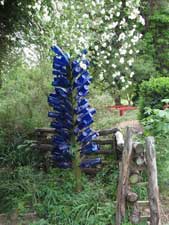Resource Library
Plant of the Week: Tree, Bottle
The University of Arkansas System Division of Agriculture does not promote, support or recommend plants featured in "Plant of the Week." Please consult your local Extension office for plants suitable for your region.
Plant of the Week
Bottle Tree

Culture is a funny thing that shapes the way we see and understand the world. Every culture is unique. However, none exists in a vacuum, so icons from one tradition are continually crossing the cultural boundaries of one group to be reinterpreted by another.
Druid priests who used evergreen trees as a part of their midwinter solstice celebrations would no doubt be bemused to see how Christians morphed their ancient tradition into the Christmas tree we now celebrate.
Bottle trees, folk symbols of the southern slave tradition, are enjoying a renaissance as they are showing up in gardens across the nation. How bottle trees migrated from the homes of poor African-American sharecroppers to suburban gardens deserves some attention.
Bottle trees, also sometimes called spirit trees, come in all shapes, sizes and colors. The best and most traditional use a dead crapemyrtle - a quintessential southern plant - adorned with blue bottles stuck willy-nilly on the cut ends of the branches. The cobalt blue milk of magnesia bottle was the standard, but brown snuff or beer bottles worked in a pinch. In their new life as folk art of American suburbia an eight-foot tall pole adorned with multicolored bottles seems to be the new favorite.
The bottle tree tradition arrived with slaves from the Congo region of Africa who believed evil spirits were trapped inside the bottles before they had a chance of getting into the home. Blue was the favorite color because spirits were especially attracted to it. In some traditions the spirits entered at night and were killed when the sun heated the bottle during the day. In others the bottles were periodically removed, plugged and set adrift in the river.
The Mississippi writer Eudora Welty worked for the WPA during the 1930s depression and photographed many bottle trees across her native state. She later wrote a short story, Livvie, in which bottle trees are featured. The modern revival of bottle trees seems to follow the relaxation of rigid rules about how to adorn a proper garden. Fun, playful and colorful is in; formality is out. Southern garden writers such as Felder Rushing from Jackson, Mississippi helped introduce them to a larger audience.
Protecting your home from bad luck - be it in the form of evil spirits, "haints" or evil doers - is only prudent and has a long tradition in most cultures. In the Ozarks, folklorist Vance Randolph says many hill people used multiple talismans for protection by using a horseshoe (with the end pointed up) over the door, by painting the door blue and for good measure nailing three nails in the doorjamb in a triangular arrangement (to represent the Trinity).
While rules are no longer in vogue, I feel some broad guidelines are in order. First, plant your bottle tree where it gets some sun. Preferably locate it where shafts of sunlight strike it through an opening in the canopy so that for a few magical minutes each day the bottle tree glows while the background is subdued in shadow. And remember, bottle trees are specimens. To be effective they must be sited where they stand out from the crowd to make a bold, startling statement.
By: Gerald Klingaman, retired
Extension Horticulturist - Ornamentals
Extension News - January 16, 2009
The University of Arkansas System Division of Agriculture does not maintain lists of retail outlets where these plants can be purchased. Please check your local nursery or other retail outlets to ask about the availability of these plants for your growing area.